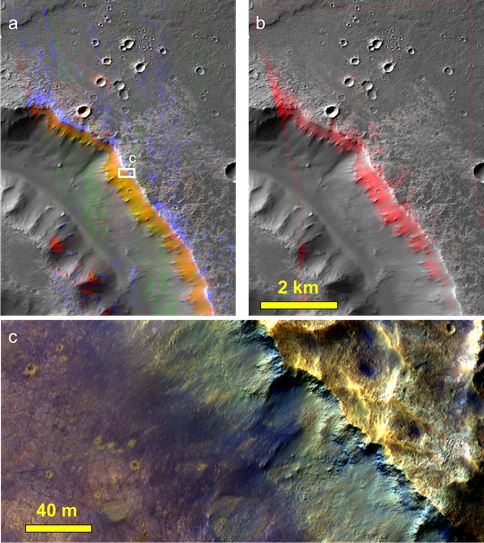2015 Annual Science Report
 SETI Institute
Reporting | JAN 2015 – DEC 2015
SETI Institute
Reporting | JAN 2015 – DEC 2015
Characterizing Carbonate Outcrops on Mars
Project Summary
Carbonate-rich rocks have been proposed for decades as a possible sink for a thicker CO2-rich atmosphere on early Mars. We are mapping new detections of carbonates in ancient (Noachian) rocks in several regions of the martian southern highlands. These rocks represent enticing astrobiological targets for understanding paleo-environments, habitability and carbon cycling via in situ study with a future landed mission.
Project Progress
We have completed spectral and associated stratigraphic analysis of carbonate-bearing outcrops primarily in the Huygens crater and northwest Noachis Terra regions of the martian highlands. Laboratory spectra of Fe- and/or Ca-rich carbonates show that these outcrops are distinct from the Mg-rich carbonates identified previously via remote sensing of martian dust and from some of the outcrops surrounding the Isidis basin. The Huygens crater and Noachis Terra carbonate outcrops always co-occur with phyllosilicates, and the overlapping spectral absorptions of these two mineral classes pose challenges for mapping them independently. We speculate that this may have led to an underappreciation of how widespread carbonate outcrops are on Mars.
The Early Noachian age implied by the stratigraphic position of these carbonate outcrops (e.g., underlying Hellas basin ejecta) implies that they record very early conditions of prime astrobiological interest for future missions such as Mars 2020. Burial to depths of several kilometers may have protected them from later acidic surface weathering until relatively recent exposure by impact, tectonics, and erosion.
We have also focused (Co-Investigator Bishop) on global comparisons of martian carbonate spectra and how variations in the absorption band positions indicate a range of cation chemistries. This work was presented at the Astrobiology Science Conference in Chicago.
Wray contributed carbonate spectral analyses to two presentations on potential future landing sites: one on Holden crater led by Ross Irwin at the Mars 2020 Landing Site Workshop, and the other on Huygens basin led by Paul Niles at the First Landing Site / Exploration Zone Workshop for Human Missions to the Surface of Mars.
-
PROJECT INVESTIGATORS:
-
PROJECT MEMBERS:
Janice Bishop
Co-Investigator
Mary Beth Wilhelm
Collaborator
-
RELATED OBJECTIVES:
Objective 2.1
Mars exploration.
![Figure 1. Carbonate-bearing rocks found on Mars to date, on MOLA topography (modified from Ehlmann et al. [2008]). Green points are Mg-carbonates (reported by Ehlmann et al. [2008], except where indicated), cyan are Fe/Ca-carbonates reported by other authors, while dark blue points are newly reported here (mostly Fe/Ca-carbonates).](../../../../media/medialibrary/2016/04/Wray_RA1_Figure1.png.484x0_q85.png)


